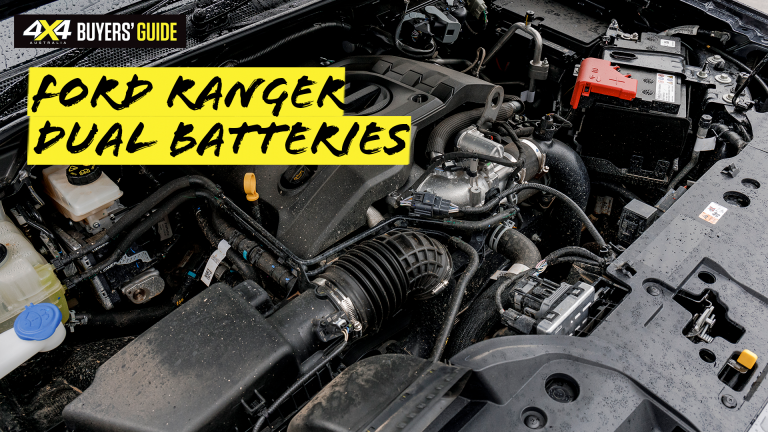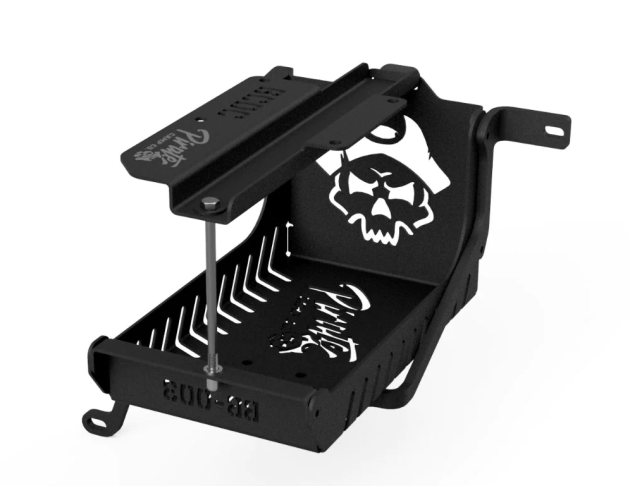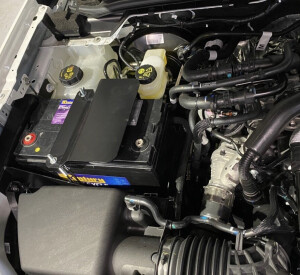
A reliable power source is essential for 4x4 enthusiasts, and a dual-battery system is an excellent way to ensure your Ranger has enough power for every adventure.
Dual-battery systems help to extend the lifespan of your battery and electronics, making it a worthwhile investment for any serious off-roader.
Here are four products we recommend. They’re intended as a starting point, to give you an idea of what’s available. We’ve included information on Ford Australia’s genuine accessories, in case you’d prefer to stick to OEM.
What it is: A second battery system and associated hardware, to run accessories such as fridges the battery and charging systems.
Why you need it: Fridges, radios, laptops and other accessories can significantly drain a battery, leaving insufficient power to start the car. A car battery isn’t designed for powering appliances long-term; it’s designed to deliver a lot of power for just a moment to start the car. So the best thing to do is to create a second electrical system for accessories.
Buying tips: The Ranger is not unique or special compared to other modern vehicles, so any auto electrician should be able to create a dual-battery system. We have listed below some of the Ranger NG specific kits, especially trays to hold the batteries, as that’s the part which tends to be unique to a given vehicle.
For the battery itself you may also consider a lithium battery as the second battery; compared to the older AGM design, lithiums are much lighter, smaller and can be discharged lower than the AGMs. However, they are much more expensive.
| Battery tray: | Charger: | Cabling: | Battery: | Location: | |
|---|---|---|---|---|---|
| Pirate Camp Co under-bonnet auxiliary battery mount | Yes | Mounts Redarc BCDC1225D | Option | Not included | Under bonnet |
| ARB Auxiliary Battery Kit | Yes | Redarc BCDC1225D | Up to BCDC input only | Not included | Under bonnet |
| 4x4 & Outdoor Battery Kit | Yes | Option | Option | Option up to 120Ah | Under bonnet |
| Off Road Downunder Battery Kit | Yes | Option | Option | Option up to 40Ah lithium | Under rear seat |
| Custom Lithium Battery Kit | Yes | Option | Option | 100Ah ultra-slim lithium | Behind rear seat |
Ford Australia/ARB licensing agreement
Ford Australia has a licensing agreement with ARB. Order ARB accessories when you order your next-gen Ranger, and they’ll be covered by Ford’s five-year warranty. So if you have a warranty issue, there are no grey areas about which company’s responsible.
If you order ARB accessories after purchase (through a Ford dealer), they’ll be covered by the remainder of the warranty period.
If you’d like to know more about the Ford/ARB partnership, then go here.
Pirate Camp Co under-bonnet auxiliary battery mount
Pirate Camp Co. has introduced an under-bonnet auxiliary battery mount specifically designed for 2022+ Ford Ranger and Everest models.
The mount accommodates a range of battery types and is compatible with Redarc BCDC battery chargers. It has a maximum weight rating of 25kg and is made of high-quality 304-grade stainless steel with a durable powder-coated texture in black.
The tray is suitable for other batteries, including lithium options, with a maximum height of 190mm. It is 100 per cent Australian made and owned.

Specifications:
- Battery tray: Yes
- Charger: Mounts a Redarc BCDC1225D
- Cabling: Option
- Battery: Not included
- Location: Under bonnet
Things we like
- Mounts Redarc BCDC charger
- Maximum battery height of 190mm
- Easy DIY installation
Not so much...
- N/A
ARB auxiliary battery kit
This is a kit that allows for an auxiliary battery to be added to the engine bay of the Ford Ranger, in order to power additional items without draining the main battery.
It includes a battery tray, mounting bracket, charger, wiring, and hardware, but does not include the battery or outlet wiring. It is not compatible with the Ranger Raptor model. It is a licensed accessory by ARB that is backed by a Ford warranty.

Specifications:
- Battery tray: Yes
- Charger: Redarc BCDC1225D
- Cabling: Up to BCDC input only
- Battery: Not included
- Location: Under bonnet
Things we like
- High-quality Redarc BCDC charger
- All wiring supplied up to BCDC input
Not so much...
- Battery not included
- Under-bonnet location kills batteries
4x4 Outdoor battery kit
This next-gen Ranger and Everest dual battery under-bonnet tray accommodates batteries up to 120Ah or those with dimensions of 185mm(W) x 345mm(L) x 220mm(H) or smaller. It is compatible with V6 and bi-turbo models.
The kit includes a tray and under-support brace. The kit is easy to install and suitable for DIY installation, with an available installation video for reference.

Specifications:
- Battery tray: Yes
- Charger: Option
- Cabling: Option
- Battery: Option up to 120Ah
- Location: Under bonnet
Things we like
- Build kit to suit your needs
- DIY or workshop installation options
- Installation video available
Not so much...
- Battery under hot bonnet
Off Road Downunder battery kit
The Long Weekender Series battery tray is designed for the 2022+ Ford Ranger RA and is a precision laser-cut battery tray that fits the Invicta Lithium 40Ah battery under the rear seat.
The tray is made of 2mm-thick Australian mild steel and features a durable powder-coated finish. The kit includes the battery tray base, side mounting bracket, heavy-duty cam-buckle strap, installation bolt kit, and step-by-step instructions.

Specifications:
- Battery tray: Yes
- Charger: Option
- Cabling: Option
- Battery: Option up to 40Ah lithium
- Location: Under rear seat
Things we like
- Away from engine-bay heat ·
- Uses otherwise empty space
Not so much...
- Limited battery capacity
- Need to drill holes for installation
Custom Lithium battery kit
A complete vehicle mounting kit positioned behind the rear seat of the 2022+ Ford Ranger (RA) 2022+ is designed for models with the Premium Audio pack. This customisable kit allows you to mix and match components to create the perfect setup for your adventure.
You can choose the battery capacity that suits your needs and add components required to charge your battery and power your devices. The kit weighs 15kg and has dimensions of 600 x 400 x 60mm

Specifications:
- Battery tray: Yes
- Charger: Option
- Cabling: Option
- Battery: 100Ah ultra-slim lithium
- Location: Behind rear seat
Things we like
- Tucked away out of sight
- Large capacity battery
- Build kit to suit your needs
Buyers' guide: Dual-battery kits
What It Is
A dual battery system is a battery with its own charging system, installed in a vehicle or boat.
They’re pretty much essential for anyone who spends weekends camping or for longer touring trips. Dual battery systems enable you to charge all those devices we carry nowadays, keep the fridge cold, and power the lights around the campsite.
The battery provides 12 volt power for accessories… fridges, phones, camp lighting, and so on. By adding an inverter, you can have 240VAC on hand as well.
The charging system keeps the battery charged. It uses power from devices like solar panels.
A dual battery system is also known as a
- second battery system,
- house battery system,
- dual battery,
- second battery, or
- house battery.
As you can see, the various aliases can be super-confusing – like, who decided “house battery” was a smart name for a vehicle battery system?!
Why You Need It
Your devices need charging while you’re camping or travelling… phones, tablets, laptops, and so on. And you’ll probably have at least one fridge, plus an inverter to run 240VAC devices.
You can’t possibly run all this gear off the starting battery. It’d be flat in no time, and it’s not designed for repeated gradual discharging.
So sooner or later, your start battery will throw the towel in. Usually this happens when you’re camping alone in a remote place with no phone reception. I can tell you from first-hand experience, there’s no worse sound in the bush than the horrible dead “ticking” noise when you turn the key.
How do you avoid killing the start battery, yet still have the convenience of charging all your devices? By installing a dual battery system.
This way, you can run all kinds of devices from the second battery. The worst that can happen is you’ll run out of power and the fridge will get warm. That’s a whole lot better than being stranded in the middle of nowhere with a flat or dead starting battery.
Buying Tips
We said earlier, a dual battery system’s a battery with its own charging system. Let’s look at it more closely.
The battery must be able to handle gradual loss of charge and recharge, repeated thousands of times. In contrast, a starting battery provides a quick blast of power.
So the batteries are different. They’re called deep cycle batteries, meaning they’re happy to repeatedly cycle through deep discharges before being re-charged. A deep cycle battery is most commonly AGM (absorbed glass mat) or Lithium.
If the word Lithium makes you think of fires, don’t worry.
Deep cycle Lithium batteries are the safe LiFePo4 type, not the more volatile Lithium-ion which are notorious for catching fire.
The charging system keeps the dual battery charged. It uses one or more sources of power:
- Power from the vehicle’s original electrical system,
- Solar panels,
- An external 240 volt supply.
What charging system you use depends on your needs and budget. It can be as simple as a switch to turn on power from the vehicle’s starting battery, all the way up to a complex battery charging/monitoring/conditioning unit.
Dual battery systems come in many shapes and sizes. They broadly fit into two categories – permanent installations and portable units.
Installation Options
You can install a second battery permanently in your vehicle or it can be portable. Both have pros and cons.
Permanent Installation
Once the system’s installed, it becomes part of the vehicle. You can fit USB charging outlets, power devices like UHF radios or dashcams, and have the convenience of a 240VAC inverter. This way, they’re always connected.
For example, if you’re a tradie you can use the inverter to charge batteries for power tools on site during the week. Then on the weekend it can run the pie oven in your canopy.
The downside is you need space to fit both the battery and the charging system. And it adds extra weight, especially if you use an AGM battery.
Portable Dual Battery System
Portable units are the ideal solution for when you don’t have room for something more permanent… or if you want to share one dual battery system between two or more vehicles.
The features and battery capacity vary between units. At the lower end of the scale, you’ll get a small battery with one lighter socket for both charging and DC output. At the upper end are units like the one above. It has:
- 100Ah Lithium battery,
- 240VAC mains charger,
- Solar input,
- Solar regulator,
- Battery management system,
- Battery monitor,
- Anderson plug, USB ports, and cigarette lighter 12V outlets.
Battery Type
AGM and Lithium deep cycle batteries are the best solutions for dual battery systems. AGM is older technology and should only be discharged to 50% of capacity. So, a 100Ah AGM battery effectively only has 50Ah of useful capacity.
Lithium batteries can discharge down to 20%, giving you 80Ah of useful capacity. And there’s a twist to this tale…
Look carefully at the specs. Revolution Power for example specific their Lithium batteries as having 100Ah “nominal” capacity. This means the battery is actually larger than 100Ah… around 125Ah.
So, a quality battery with 100Ah nominal capacity has 100Ah of usable capacity. That’s double the capacity of an equivalent AGM.
The initial purchase price of Lithium batteries is many far higher than AGM batteries. However, a quality Lithium battery will last around 5,000 cycles (a cycle is one discharge and one recharge). In contrast, an AGM only lasts around 600 cycles for the same application.
When you compare whole of life costs, a Lithium battery wins hands down.
There are other benefits to choosing Lithium over AGM. The most obvious is usable capacity. Quite simply, your Lithium battery will run your fridge for double the time, when compared to an AGM. This can mean the difference between a campsite with power on a cloudy day… or a hot fridge and no lighting.
Another benefit is weight.
A Lithium battery is about half the weight of an AGM. For example, a 100Ah AGM weighs about 30kg while a 100Ah Lithium is around 14kg.
Combine the weight savings with the doubled capacity of equivalent battery types, and the benefits of Lithium keep stacking up. You halve the space and reduce weight by three quarters (14kg instead of 60kg).
In short, if you’re on a tight budget then AGM batteries are the only choice. But if you can afford a bit more, you’ll save a stack of weight, space, and money in the long run.
Charging the Battery
The charging system can be as simple as a solar panel with a voltage regulator and alligator clamps for connection to the battery.
However, it’s great to be able to charge the battery from a few sources… solar, the vehicle, and an external 240VAC supply. In this case you’ll need a controller, also known as a battery management system or a DC-DC charger.
A controller has two jobs:
- Choose the best available power source (solar, vehicle, and so on), and
- Continually monitor the battery’s condition then charge it accordingly.
Any decent controller will operate as a battery charger, known as a DC-DC charger. It will monitor the battery and charge it using several charging stages.
There are thousands of different controllers available. Choose one to suit your needs and your budget. One handy feature is a digital readout of the battery’s charge level, so you can check it at a glance.
Finally, if you go with a Lithium battery then make sure the controller is compatible with charging of Lithium LiFePo4 batteries.
Where to Install the System
Until now, the typical dual battery installation in a 4WD has been under the bonnet. With engines becoming more complex, under-bonnet real estate is getting harder to find.
But even if you do have space under the bonnet, try to find a better location. Heat kills batteries, especially Lithium batteries.
In fact, don’t even think about sticking a Lithium battery under the bonnet. Find a spot in the tray or under a seat instead.
What to Look For
When it comes to deep cycle batteries, you get what you pay for. A cheap battery is cheap for a reason.
This is especially true for Lithium batteries. They have an internal battery management system, cabling, and a bunch of Lithium cells.
Manufacturers of cheap Lithium batteries have to cut costs somewhere. They might use inferior quality components, cut corners during assembly, or even supply cells which don’t store the claimed battery capacity.
This last point is important.
We said earlier how quality Lithium batteries usually specify nominal capacity. So a Lithium battery advertised as 100Ah will deliver 100Ah of usable capacity. However, the cheaper batteries use the smallest capacity they can get away with… remember how we said they need to cut costs?
The outcome? You buy a cheap Lithium battery rated at 100Ah and you only get 80Ah usable capacity. In short, you’re getting ripped off.
Worse still, yes there are stories of Lithium LiFePo4 batteries catching fire. But the Lithium cells aren’t combustible, so how do they catch fire? It comes down to poor assembly. Wires short out and the electronic components catch fire.
That alone is a good reason not to buy cheap Lithium batteries.
As for the controller, look for one which suits your needs. If you have solar panels, make sure the controller has a solar input. If you only camp at caravan parks, make sure it has a 240VAC input. You get the idea.
A dual battery system will make your camping life so much easier. Once you get one, you’ll wonder how you managed without it.
How we review products
4X4 Australia has been reviewing four-wheel drive vehicles and aftermarket products for more than 40 years.
When looking for the best accessories for your make and model of 4WD, there are some things essential to making sure you have the best off-roading experience.
When we compare products, here are some of the things we consider:
- Warranty
- Build quality
- Value for money
- Time and ease to set-up/install
- Weight
- Fit and finish
- How well it gets the job done
- What materials they’re made from
- Corrosion/UV resistance
- Coatings
- Compatibility with other accessories
- Compliance with ADRs and vehicle safety systems
- Country of manufacture
- Load ratings,
to determine what's the best product across each price point.
We also consider user reviews and our own experience with these products to make sure our recommendations are for the best on the market.
Disclosure: When you buy through our links, we may earn a commission. We also include products that we do not earn a commission from.

COMMENTS